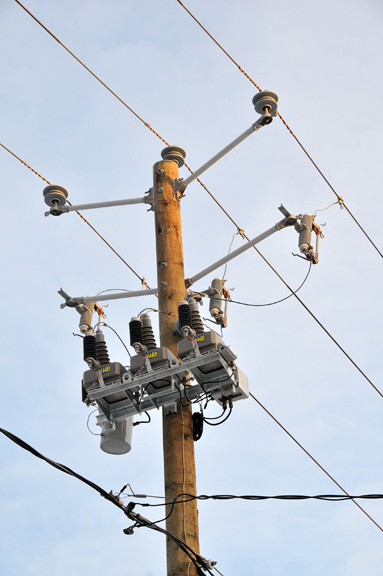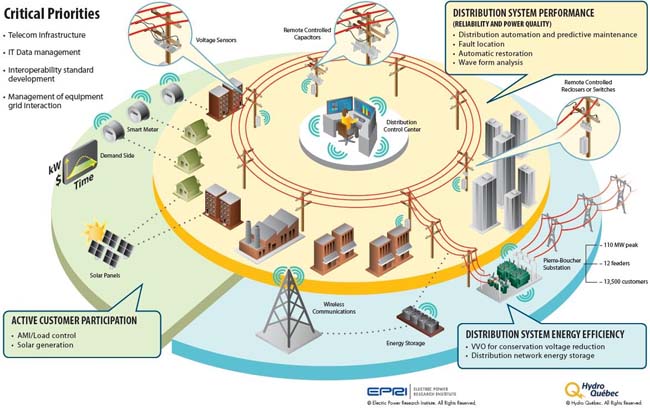Interactive Smart Grid Zone Demonstration in Québec
Lead Proponent: Hydro Québec
Location: Boucherville, Québec
CEF Contribution: $ 7.5 M
Project Total: $ 49.8 M
Project Background

Hydro-Québec’s Smart Grid Zone project is an experiment with smart grid technologies in the city of Boucherville in Quebec.
The interactive network project was launched in order to improve the distribution grid’s energy efficiency and performance. The tested area is supplied by the Pierre-Bouchon station that services primarily the city of Boucherville. The project aims to verify that Volt and VAR optimization systems help to reduce energy consumption and distribution grid losses without affecting the power quality delivered to clients. It also aims to test the performance, compatibility and integration into the operations of all technologies tested (refer to chart).
The Project has three components:
- Distribution Management System (DMS) and Volt & Var Optimization (VVO) component
- Electric Vehicle (EV) Recharging component
- Advance Metering Infrastructure (AMI) load control component
Results
For the DMS (Distribution Management System) with CATVAR (voltage regulation and reactive power control), new features have been added to the current grid management tool, making it possible to demonstrate the feasibility and performance of CATVAR technology. CATVAR features will be further developed in a DMS-type commercial tool.
A major step was taken in reactive power management. This is the first time the transmission provider’s reactive power needs have been taken into account by the distributor in reactive power management of the distributor. To date, only Hydro-Québec has managed to achieve integrated real-time reactive power management.
For DMS with integrated voltage control - CATVAR (voltage regulation and reactive power control), proper grid modeling is essential (equipment specifications, phasing, load pattern). In particular, voltage imbalance on the distribution grid poses a real challenge when voltage level optimization is required to reduce energy consumption. As well, system calibration requires that voltage measurement be done at client level. Finally, collaboration with the transmission network allows for improved optimization of energy reductions. During deployment of the automation project, it was necessary to revise the design of the control boxes in order to ensure a more seamless visual and environmental integration in urban areas. This experience shows how important it is to inform public agencies that may be affected by the various projects as soon as possible.
Electric vehicle charging stations have been acquired for laboratory testing of their performance in our weather conditions and for pilot tests in real installations. A simulation tool has also been developed to assess the impact of electric vehicle charging on the distribution grid in terms of energy and power. Forty-eight charging stations have been installed and 30 electrical vehicles have been launched.
All in all, 5,800 new-generation residential meters have been installed as part of the AMI and load control component. The Advance Metering Infrastructure (AMI) uses a meshed telecommunications network radio frequency technology. These meters transmit information to a data acquisition and archiving system. The data analyzed can be used to better understand the behaviour of energy and therefore better manage it.

Text Version
The illustration shows the electrical distribution grid. It illustrates how the different technologies for reducing energy consumption and grid losses are related. Three main elements are displayed:
- Distribution grid performance; a distribution grid control centre (DGCC) is used to validate energy optimization systems through various electrical, telecommunications and computer equipment installed on the distribution grid.
- Energy efficiency of the distribution grid; via the DGCC, electrical station and wireless communication management will enable validation of Volt and reactive power control optimization systems.
- Active client participation; some clients in the interactive smart grid demonstration area will also participate in optimization systems validation by smart meters and through clean energy source integration.
The illustration is a trademark of Hydro-Québec and Electric Power Research Institute (EPRI). All rights reserved.
Benefits to Canada
The Clean Energy Fund contribution to this project will accelerate the developing of “Smart Grid” renewable and energy efficiency technologies. The project will also assist electrical distribution utilities in adapting these technologies and hence in reducing greenhouse gas emissions in Canada.
Next Steps
Hydro-Québec’s goal is to ensure that the technologies and solutions adopted are a permanent fixture. Hydro-Québec will also monitor the supply in the market of DMS and VVO technologies.
The deployment of AMI technology will enable our clients to monitor and carefully manage their power consumption.
Page details
- Date modified: